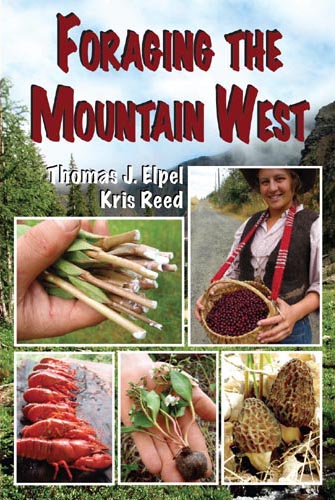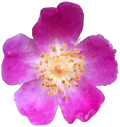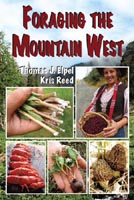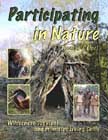|

Rosaceae
Plants of the Rose Family
If you have ever buried your nose into an apple, rose, strawberry, or cherry blossom, then you know the Rose family. Roses have alternate leaves, which vary from simple to trifoliate, palmate, or pinnate. The whole leaves or smaller leaflets are frequently more or less oval-shaped with serrated edges, which is a good secondary pattern for recognizing the Rose family. As for the flowers, there are typically 5 (rarely 3 to 10) separate sepals and a similar number of petals. There are a minimum of 5 stamens, but often many more, usually in multiples of five. Many flowers of the Rose family, especially those of the Rose subfamily, have several to numerous simple pistils, or the pistils may be united at the base, with the styles separate, making a single compound pistil with numerous styles. Either way, the result is a distinctive, fuzzy-looking center surrounded by lots of stamens. Plants of the Rose family form many different fruits, varying from fleshy fruits to various false fruits, dry seeds, capsules, or follicles.
Worldwide, there are about 100 genera and 3,000 species. About 50 genera are found in North America. The Rose family produces many edible fruits. Tannins are common in the vegetation, giving astringent properties. Cyanide compounds are found in the leaves and fruits of some species.
In the early 1900s, botanists reclassified the former Spirea, Plum, and Apple families as subfamilies within the Rose family. In response, Robert Frost poemed, "The rose is a rose and was always a rose. But the theory now goes that the apple's a rose, and the pear is, and so's the plum, I suppose. The dear [Lord] only knows what will next prove a rose. You, of course, are a rose - but were always a rose."
Taxonomists have since determined that the Spiraea, Plum, and Apple subfamilies did not represent genetically distinct lines, but should more properly combined as a single subfamily, now known as the Almond subfamily, Amygdaloideae. When you have a specimen in hand, then read through each of the subfamilies to narrow down the choices for identification.
Key Words: 5 sepals and 5 petals with usually numerous stamens. Oval, serrated leaves.
Subfamilies of the Rose Family
Rose Subfamily | Dryad Subfamily
Almond Subfamily: Spiraeas | Plums | Apples
Please e-mail Thomas J. Elpel to report mistakes or to inquire about purchasing high resolution photos of these plants.
Rose Subfamily: Rosoideae
These members of the Rose Family have numerous stamens and numerous styles.

Most flowers of the Rose subfamily have a slightly domed receptacle beneath the pistils. Some species resemble Buttercups with their numerous stamens and numerous simple pistils attached to a cone-like receptacle. But it is easy to determine the difference. There are often stipules at the base of leaves in the Rose subfamily, but never in the Buttercups. Stipules are small, leaf-like growths at the base of the leaf stems.
Plants of the Rose subfamily have multiple separate pistils (sometimes basally united). Botanically speaking, the ovary from each pistil matures into its own fruit, which is a dry seed (achene) in most Roses. However, there are some interesting false fruits. In the rose, for example, each ovary produces a dry seed, all of which are enclosed within a fleshy receptical that greatly resembles a fleshy ovary. The strawberry is similar, but inverted, with the dry seeds embedded on the surface of a fleshy receptical. The raspberry, however, does have fleshy fruits; the ovary of each simple pistil swells to create an aggregate fruit covering a domed receptacle.
 Rosa acicularis. Prickly Rose. |
 Rosa acicularis. Prickly Rose. |
 Rosa woodsii. Wood's Rose. |
 Rosa woodsii. Wood's Rose. |
 Rosa sp. Wild Rose Hips. Pony, Montana. |  Rosa gymnocarpa. Baldhip Rose. Unlike other species, the fruits of the baldhip rose drop their sepals. |
 Fragaria vesca. Wild Strawberry. |  Frageria virginiana. Wild Strawberry. |
 Fragaria sp. Wild Strawberries. |
 Fragaria sp. Wild Strawberries. |

Foraging the Mountain West |
 Duchesnea indica (a.k.a. Potentilla indica). Mock Strawberry. Yellow flowers. Introduced from Asia as an ornamental. Photographed at Brigham Young University in Rexburg, Idaho. |
 Fallugia paradoxa. Apache Plume. Native to the American Southwest. |
 Geum macrophyllum. Yellow Avens. |
 Geum triflorum. Prairie Smoke. |  Geum triflorum. Prairie Smoke. |
 Potentilla anserina. Silverweed Cinquefoil. Harrison Lake. Near Harrison, Montana. |  Potentilla glandulosa. Sticky Cinquefoil. |
 Potentilla recta. Sulphur Cinquefoil. Introduced and invasive. |  Potentilla recta. Sulphur Cinquefoil. |
 Pentaphylloides floribunda (a.k.a. Potentilla fruticosa) Shrubby Cinquefoil. Tobacco Root Mountains. Pony, Montana. |  Pentaphylloides floribunda (a.k.a. Potentilla fruticosa) Shrubby Cinquefoil. |
 Rubus parviflorus. Thimble Berry. |  Rubus parviflorus. Thimble Berry. |
 Rubus armeniacus (a.k.a. Rubus discolor). Himalayan Blackberry. |
 Rubus armeniacus (a.k.a. Rubus discolor). Himalayan Blackberry. |
 Rubus armeniacus (a.k.a. Rubus discolor). Himalayan Blackberry. |

Foraging the Mountain West |
 Rubus leucodermis. Blackcap Raspberry. |  Rubus laciniatus. Cutleaf Evergreen Blackberry. |
 Rubus idaeus. Raspberry. |  Rubus spectabilis. Salmonberry. |
Dryad Subfamily: Dryadoideae
In the flowers and shrubs of the Dryad subfamily, the ovary matures as a dry seed (achene). The style remains attached to the ovary, usually forming a distinctive feathery plume attached to each seed. (Also found in Geum triflorum and Fallugia paradoxa of the Rose subfamily.) Like members of the Pea family, Dryads associate with nitrogen-fixing bacteria in the soil, forming nodules on the roots. The bacteria absorb nitrogen from the air and make it available to the plants. In exchange, the plants photosynthesize sugars for the bacteria. .
 Dryas octopetala. Mountain Avens. |  Dryas octopetala. Mountain Avens. An alpine flower. |
 Cercocarpus montanus. Mountain Mahogany. |  Cercocarpus montanus. Mountain Mahogany. Photographed in Red Rocks Park, Colorado. Common throughout the Rocky Mountains. |
 Purshia tridentata. Bitterbrush. |  Purshia tridentata. Bitterbrush. |
Almond Subfamily: Spiraeas - Amygdaloideae
The Almond subfamily includes the former Spiraea, Plum, and Apple subfamilies. There was some genetic overlap between these groups, which necessitated combining them. For example, some genera were previously classified as Spiraeas, but are more closely related to Plums or Apples. Nevertheless, the traditional grouping remains useful for the purposes of identification.
Spiraea-type plants are mostly shrubs with foamy-looking, dense clusters of usually small white or pink flowers, often with stamens dangling beyond the petals. Unlike the Rose subfamily, these plants do not have stipules on the leaves. The ovary is positioned superior with 2 to 5 (rarely 1 to 12) simple pistils, which may be partially fused at the base. Fruits of this group include capsules, follicles (unicarpellate dry fruits that split along a seam), or sometimes achenes (dry seeds).
 Spiraea betulifolia. Birch Leaf Spiraea. |
 Spiraea betulifolia. Birch Leaf Spirea. Tobacco Root Mountains. Pony, Montana. |
 Spiraea betulifolia. Birch Leaf Spiraea. |

Foraging the Mountain West |
 Spiraea douglasii. Western Spiraea. |

Douglas spirea: Spiraea douglasii. Western spirea is native to western North America, this one photographed as an introduced plant in Sweden. |
 Physocarpus malvaceus. Ninebark. |  Physocarpus malvaceus. Ninebark. A common shrub in Rocky Mountain forests. |
 Holodiscus discolor. Ocean Spray. |

Foraging the Mountain West |
Almond Subfamily: Plums - Amygdaloideae
Plums, cherries, apricots, peaches, nectarines, and almonds are all included in the Prunus genus. With most of these species, we eat the fleshy fruit and throw the pit away, but in the almond (P. dulcis), we discard the fleshy fruit and crack open the pit to eat the nut. The ovary is positioned mostly or wholly superior and usually consists of a single carpel (unicarpellate) (2 to 5 carpels in Oemleria) forming a single chamber that matures as a drupe (a fleshy fruit with a stony seed). Next time you see one of these fleshy fruits, notice the "seam" down one side, and the almond-like pit in the middle; those are the obvious marks of Prunus and it closest allies.
The fruits and/or nuts of any species of Prunus are technically edible, but the nuts contain amygdalin, a glycoside that breaks down into benzaldehyde and cyanide. Benzaldehyde is the source of the bitter almond flavor, often utilized in cooking. The degree of bitterness is a good indicator of the concentration of amygdalin in the raw nut. Amygdalin, also known as laetrile or Vitamin B17, is considered beneficial in small doses, but excess consumption leads to cyanide poisoning. Cyanide prevents cells from utilizing oxygen in the bloodstream, resulting in asphyxiation at the cellular level. Proper cooking, drying, and/or oxidation destroys the cyanide, making the pit-or rather the nut inside the pit-edible.
 Prunus virginiana. Chokecherry. |  Prunus virginiana. Picking Chokecherries. Twisp, Washington. |
 Prunus mahaleb. Mahaleb Cherry. |  Prunus mahaleb. Mahaleb Cherry. Twisp, Washington. |
 Prunus tomentosa. Nanking Cherry. |  Prunus tomentosa. Nanking Cherry. |
 Prunus americana. American Wild Plum. |  Prunus americana. American Wild Plum. |
 Prunus cerasifera. Cherry plum. Native to Europe and Asia. Naturalized from homesteads in some parts of North America. |
 Prunus cerasifera. Cherry plum. Photographed in Hells Canyon, Idaho. |
 Prunus avium. Sweet Cherry. Native to Europe and Asia. Naturalized from homesteads in some parts of North America. |
 Prunus avium. Sweet Cherry. Photographed near Kettle Falls, Washington. |
 Prunus armeniaca. Apricot. |
 Prunus armeniaca. Apricot. |
Almond Subfamily: Apples - Amygdaloideae
If you find a Rose family plant with fleshy fruits and a five-pointed star on the bottom then it belongs to the apple group of the Almond Subfamily. The only other fleshy fruit of the Rose family with a five-pointed star is the rose itself (see the Rose subfamily). In apple-type flowers, the ovary is positioned inferior, leaving the remains of the flower attached to the tip of the fruit. The fruit is a false fruit known as a pome. Rather than being formed as a swollen ovary, the fleshy fruit is formed from the enlarged receptacle around the ovary.
All of these apple-type fruits are more or less edible, although some, like the mountain ash (Sorbus), can be highly sour-astringent. Other cultivated members of the Apple subfamily include the apple (Malus), pear (Pyrus), quince (Cydonia), loquat (Eriobotrya), Christmasberry (Photinia), and Pyracantha. The fruits of most of these plants are sweeter after a frost. Note that berries from the Heath family / Blueberry subfamily have a similar five-pointed star from the leftover sepals.

Black Chokeberry: Aronia melanocarpa. |
 Cydonia oblonga. Quince. Cultivated. |
 Malus fusca. Pacific Crabapple. |  Malus fusca. Pacific Crabapple. |
 Amelanchier utahensis. Utah Serviceberry. |  Amelanchier utahensis. Utah Serviceberry. Canyon de Chelly National Monument. Arizona. |
 Amelanchier alnifolia. Serviceberry. |  Amelanchier alnifolia. Serviceberry. |
 Amelanchier alnifolia. Serviceberry. |  Crataegus sp. Hawthorn. |
 Pyracantha sp. Pyracantha. An ornamental shrub. Lake Mead. Nevada. |  Pyracantha coccinea. Pyracantha. Spokane, Washington. |
 Sorbus scopulina. Mountain Ash. |  Sorbus scopulina. Mountain Ash. |
 Sorbus scopulina. Mountain Ash. |  Sorbus sitchensis. Sitka Mountain Ash. |
There are more
Rose Family pictures
at PlantSystematics.org.
Return to the Plant Families Index
Return to the Wildflowers & Weeds Home Page
|






















































































